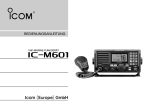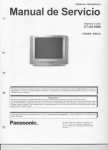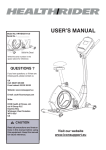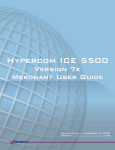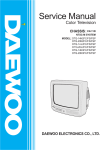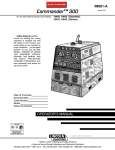Download Daewoo DTQ 29S1FCN Service manual
Transcript
Service Manual Color Television CHASSIS : CN-200I/A NTSC-M SYSTEM MODEL: DTQ-26S1FC/FS/FSP(CN-200I) DTQ-29S1FCN/FSN/FSP(CN-200I) DTQ-26S1HC/HS/HSP(CN-200A) DTQ-29S1HC/HS/HSP(CN-200A) ✔ Caution : In this Manual, some parts can be changed for improving, their performance without notice in the parts list. So, if you need the latest parts information,please refer to PPL(Parts Price List) in Service Information Center (http://svc.dwe.co.kr). DAEWOO ELECTRONICS CO., LTD. OVERSEAS SERVICE DEPT. FEATURES FS (Frequency Synthesizer) Tuning System CATV Ready Monitor Look Design A/V IN. (Stereo) Stereo/Mono Function ELECTRICAL SPECIFICATIONS POWER INPUT FC SERIES FS SERIES FSP SERIES POWER RATING 26” MODELS 29” MODELS INTERMEDIATE FREQUENCIES PICTURE IF CARRIER FREQUENCY SOUND IF CARRIER FREQUENCY COLOR SUB CARRIER FREQUENCY AUDIO OUTPUT RATING SPEAKER ANTENNA INPUT IMPEDANCE TUNING RANGES VHF UHF CATV AC 120V 60Hz AC 85V ~ AC 150V 60Hz AC 220V 50Hz/60Hz 100W 105W 45.75MHz 41.25MHz 42.17MHz 1.2W 2 2W 8 ohm 2 VHF/UHF 75 ohm UNBALANCED 2 THRU 13 14 THRU 69 1 THRU 125 CONTENTS Safety Precautions 3 Control View 5 Important Service Notes 7 Block Diagram 8 General Adjustments 10 Trouble Shooting Charts 12 Description of Semiconductors 20 Printed Boards 21 Exploded View 23 Schematic Diagram 25 Parts List 27 Option List 36 2 Product safety servicing guidelines for color television receivers A.C. VOLTMETER CAUTION : Do not attempt to modify this product in any way. Unauthorized modifications will not only void the warranty, but may lead to your being liable for any resulting property damage or user injury. Service work should be performed only after you are thoroughly familiar with all of the following safety checks and servicing guidelines. To do otherwise, increases the risk of potential hazards and injury to the user. Good earth ground, such as the water pipe, conduit, etc. 0.15µF • • 1500 OHM 10WATT SAFETY CHECKS After the original service problem has been corrected, a check should be made of the following: Place this probe on each exposed metal part. GRAPHIC SYMBOLS : 1. Be sure that all components are positioned in such a way as to avoid possibility of adjacent component shorts. This is especially important on those chassis which are transported to and from the repair shop. The lightning flash with arrowhead symbol, within an equilateral triangle, is intended to alert the service personnel to the presence of uninsulated dangerous voltage that may be of sufficienty magnitude to constitute a risk of electric shock. 2. Never release a repair unless all protective devices such as insulators, barriers, covers, shields, strain reliefs, and other hardware have been reinstalled per original design. The exclamation point within an equilateral triangle is intended to alert the service personnel to the presence of important safety information in service literature. SUBJECT : FIRE & SHOCK HAZARD 3. Soldering must be inspected to discover possible cold solder joints, frayed leads, damaged insulation (including A.C. cord), solder splashes or sharp solder points. Be certain to remove all loose foreign particals. Fuse symbol is printed on pcb adjacent to the fuse, with RISK OF FIRE REPLACE FUSE AS MARKED . The symbol is explained in the service manual with the following wording or equivalent. CAUTION : FOR CONTINUED PROTECTION AGAINST FIRE HAZARD, REPLACE ONLY WITH SAME TYPE 4A, 125V FUSE and ATTENTION: AFIN D ASSU UNE PROTECTION PERMANENTE CONTRE LES RISQUES D INCENDIE, REMPLACER UNIQUEMENT PAR UN FUSIBLE DE MEME TYPE ET DE 4A, 125V . 4. Check for physical evidence of damage or deterioration to parts and components, and replace if necessary follow original layout, lead length and dress. 5. No leads or components should touch a receiving tube or a resistor rated at 1 watt or more. Lead tension around protruding metal surfaces must be avoided. 6. All critical components such as fuses, flameproof resistors, capacitors, etc. must be replaced with exact factory types. Do not use replacement components other than those specified or make unrecommended circuit modifications. SUBJECT : X-RADIATION 1. Be sure procedures and instructions to all service personnel cover the subject of X-rays in current T.V. receivers is the picture tube. However, this tube does not emit X-rays when the high voltage is at the factory specified level. The proper value is given in the applicable schematic. Operation at higher voltages may cause a failure of the picture tube or high voltage supply and, under certain circumstances, may produce radiation in excess of desirable levels. 7. After re-assembly of the set always perform an A.C. leakage test on all exposed metallic parts of the cabinet, (the channel selector knob, antenna terminals, handle and screws) to be sure the set is safe to operate without danger of electrical shock. Do not use a line isolation transformer during this test. Use an A.C. voltmeter, having 5000 ohms per volt or more sensitivity, in the following manner : connect a 1500 ohm 10 watt resistor, paralleled by a 15 mfd. 150V A.C. type capacitor between a known good earth ground 9water pipe, conduit, etc.) and the exposed metalic parts, one at a time. Measure the A.C. voltage across the combination of 1500 ohm resistor and 0.15 MFD capacitor. Reverse the A.C. plug and repeat A.C. voltage measurements for each exposed metallic part. Voltage measured must not exceed 0.75 volts R.M.S. This corresponds to 0.5 milliamp A.C. Any value exceeding this limit constitutes a potential shock hazard and must be corrected immediately. 2. Only factory specified C.R.T. anode connectors must be used. Degaussing shields also serve as X-ray shield in color sets. Always re-install them. 3. It is essential that the serviceman has available an accurate and reliable high voltage meter. The calibration of the meter should be checked perio dically against a reference standard. Such as the one available at your distributor. 4. When the high voltage circuitry is operating properly there is no possibility of an X-radiation problem. Every time a color chassis is serviced, the brightness should be run up and down while monitoring the high voltage with a meter to be certain that the high voltage does not 3 exceed the specified value and that it is regulating correctly. We suggest that you and your service orgainzation review test procedures so that voltage regulation is always checked as a standard servicing procedure. And that the high voltage reading be recorded on each customer s invoice. 2. Avoid conditions of high humidity such as : Outdoor patio installations where dew is a factor. Near steam radiators where steam leakage is a factor, etc. 3. Avoid placement where draperies may obstruct rear venting. The customer should also avoid the use of decorative scarves or other coverings which might obstruct ventilation. 5. When troubleshooting and making test measurements in a receiver with a problem of excessive high voltage, avoid being unnecessarily close to the picture tobe and the high voltage compartment. Do not operate the chassis longer than is necessary to locate the cause of excessive voltage. 4. Wall and shelf mounted installations using a commercial mounting kit, must follow the factory approved mounting instructions. A receiver mounted to a shelf or platform must retain its original feet(or the equivalent thickness in spacers) to provide adequate are flow across the bottom, blots or screws used for fasteners must not touch and parts or wiring. Perform leakage test on customized installations. 6. Refer to HV, B+and Shutdown adjustment procedures described in the appropriate schematic and diagrams(where used). 5. Caution customers against the mounting of a receiver on sloping shelf or a tilted position, unless the receiver is properly secured. SUBJECT : IMPLOSION 1. All direct viewed picture tubes are equipped with an integral implosion protection system, but care should be taken to avoid damage during installation. Avoid scratching the tube. If scratched, replace it. 6. A receiver on a roll-about cart should be stable on its mounting to the cart. Caution the customer on the hazards of trying to roll a cart with small casters across thresholds or deep pile carpets. 2. Use only recommended factory replacement tubes. 7. Caution customers against the use of a cart or stand which has not been listed by underwriters laboratories, inc. For use with their specific model of television receiver or generically approved for use with T.V. s of the same or larger screen size. SUBJECT : TIPS ON PROPER INSTALLATION 1. Never install any receiver in closed-in recess, cubbyhole or closely fitting shelf space over, or close to heat duct, or in the path of heated air flow. 4 Product safety servicing guidelines for color television receivers A.C. VOLTMETER CAUTION : Do not attempt to modify this product in any way. Unauthorized modifications will not only void the warranty, but may lead to your being liable for any resulting property damage or user injury. Service work should be performed only after you are thoroughly familiar with all of the following safety checks and servicing guidelines. To do otherwise, increases the risk of potential hazards and injury to the user. Good earth ground, such as the water pipe, conduit, etc. 0.15µF • • 1500 OHM 10WATT SAFETY CHECKS After the original service problem has been corrected, a check should be made of the following: Place this probe on each exposed metal part. GRAPHIC SYMBOLS : 1. Be sure that all components are positioned in such a way as to avoid possibility of adjacent component shorts. This is especially important on those chassis which are transported to and from the repair shop. The lightning flash with arrowhead symbol, within an equilateral triangle, is intended to alert the service personnel to the presence of uninsulated dangerous voltage that may be of sufficienty magnitude to constitute a risk of electric shock. 2. Never release a repair unless all protective devices such as insulators, barriers, covers, shields, strain reliefs, and other hardware have been reinstalled per original design. The exclamation point within an equilateral triangle is intended to alert the service personnel to the presence of important safety information in service literature. SUBJECT : FIRE & SHOCK HAZARD 3. Soldering must be inspected to discover possible cold solder joints, frayed leads, damaged insulation (including A.C. cord), solder splashes or sharp solder points. Be certain to remove all loose foreign particals. Fuse symbol is printed on pcb adjacent to the fuse, with RISK OF FIRE REPLACE FUSE AS MARKED . The symbol is explained in the service manual with the following wording or equivalent. CAUTION : FOR CONTINUED PROTECTION AGAINST FIRE HAZARD, REPLACE ONLY WITH SAME TYPE 4A, 125V FUSE and ATTENTION: AFIN D ASSU UNE PROTECTION PERMANENTE CONTRE LES RISQUES D INCENDIE, REMPLACER UNIQUEMENT PAR UN FUSIBLE DE MEME TYPE ET DE 4A, 125V . 4. Check for physical evidence of damage or deterioration to parts and components, and replace if necessary follow original layout, lead length and dress. 5. No leads or components should touch a receiving tube or a resistor rated at 1 watt or more. Lead tension around protruding metal surfaces must be avoided. 6. All critical components such as fuses, flameproof resistors, capacitors, etc. must be replaced with exact factory types. Do not use replacement components other than those specified or make unrecommended circuit modifications. SUBJECT : X-RADIATION 1. Be sure procedures and instructions to all service personnel cover the subject of X-rays in current T.V. receivers is the picture tube. However, this tube does not emit X-rays when the high voltage is at the factory specified level. The proper value is given in the applicable schematic. Operation at higher voltages may cause a failure of the picture tube or high voltage supply and, under certain circumstances, may produce radiation in excess of desirable levels. 7. After re-assembly of the set always perform an A.C. leakage test on all exposed metallic parts of the cabinet, (the channel selector knob, antenna terminals, handle and screws) to be sure the set is safe to operate without danger of electrical shock. Do not use a line isolation transformer during this test. Use an A.C. voltmeter, having 5000 ohms per volt or more sensitivity, in the following manner : connect a 1500 ohm 10 watt resistor, paralleled by a 15 mfd. 150V A.C. type capacitor between a known good earth ground 9water pipe, conduit, etc.) and the exposed metalic parts, one at a time. Measure the A.C. voltage across the combination of 1500 ohm resistor and 0.15 MFD capacitor. Reverse the A.C. plug and repeat A.C. voltage measurements for each exposed metallic part. Voltage measured must not exceed 0.75 volts R.M.S. This corresponds to 0.5 milliamp A.C. Any value exceeding this limit constitutes a potential shock hazard and must be corrected immediately. 2. Only factory specified C.R.T. anode connectors must be used. Degaussing shields also serve as X-ray shield in color sets. Always re-install them. 3. It is essential that the serviceman has available an accurate and reliable high voltage meter. The calibration of the meter should be checked perio dically against a reference standard. Such as the one available at your distributor. 4. When the high voltage circuitry is operating properly there is no possibility of an X-radiation problem. Every time a color chassis is serviced, the brightness should be run up and down while monitoring the high voltage with a meter to be certain that the high voltage does not 3 exceed the specified value and that it is regulating correctly. We suggest that you and your service orgainzation review test procedures so that voltage regulation is always checked as a standard servicing procedure. And that the high voltage reading be recorded on each customer s invoice. 2. Avoid conditions of high humidity such as : Outdoor patio installations where dew is a factor. Near steam radiators where steam leakage is a factor, etc. 3. Avoid placement where draperies may obstruct rear venting. The customer should also avoid the use of decorative scarves or other coverings which might obstruct ventilation. 5. When troubleshooting and making test measurements in a receiver with a problem of excessive high voltage, avoid being unnecessarily close to the picture tobe and the high voltage compartment. Do not operate the chassis longer than is necessary to locate the cause of excessive voltage. 4. Wall and shelf mounted installations using a commercial mounting kit, must follow the factory approved mounting instructions. A receiver mounted to a shelf or platform must retain its original feet(or the equivalent thickness in spacers) to provide adequate are flow across the bottom, blots or screws used for fasteners must not touch and parts or wiring. Perform leakage test on customized installations. 6. Refer to HV, B+and Shutdown adjustment procedures described in the appropriate schematic and diagrams(where used). 5. Caution customers against the mounting of a receiver on sloping shelf or a tilted position, unless the receiver is properly secured. SUBJECT : IMPLOSION 1. All direct viewed picture tubes are equipped with an integral implosion protection system, but care should be taken to avoid damage during installation. Avoid scratching the tube. If scratched, replace it. 6. A receiver on a roll-about cart should be stable on its mounting to the cart. Caution the customer on the hazards of trying to roll a cart with small casters across thresholds or deep pile carpets. 2. Use only recommended factory replacement tubes. 7. Caution customers against the use of a cart or stand which has not been listed by underwriters laboratories, inc. For use with their specific model of television receiver or generically approved for use with T.V. s of the same or larger screen size. SUBJECT : TIPS ON PROPER INSTALLATION 1. Never install any receiver in closed-in recess, cubbyhole or closely fitting shelf space over, or close to heat duct, or in the path of heated air flow. 4 CONTROL VIEW F-CONNECTOR 300 OHM-75 OHM COUPLING TRANSFORMER VHF 75Ω FROM 75 OHM VHF ANTENNA WITH CABLE OR CABLE TV SYSTEM 5 1. Overview of Your Equipment Your TV comes with a remote control. The section below summarizes the buttons,controls, and terminals that you will use with your TV. 2. Your TV' s Front Panel 1. POWER Use this buttom to turn your TV on or off. 2. CH Use these buttom to change channels on your TV, or to select items in the menu system. 3. VOL Use these buttom to change your TV s volume, to activate selections in the menu system, or to change audio and video settings. 4. MENU Use this buttom to turn the TV s menu system on and off. 5. Remote control receiver This receiver receives a signal from your remote control. Do not block it. 3. Your TV' s Back Panel 1. Antenna terminal Use this terminal to attach an antenna or cable system to your TV. 2. VIDEO IN This terminal allows the TV to receive a video signal from another components, such as a VCR. 1 2 4 3 3. AUDIO R/MONO IN This terminal allows the TV to receive an audio R/MONO signal from another components, such as a VCR. 4. AUDIO L IN This terminal allows the TV to receive an audio L signal from another components, such as a VCR. 6 IMPORTANT SERVICE NOTES tion transformer during this check). Use an AC voltmeter having 5000 ohms per volt or more sensitivity in the following manner. 1. X-RAY RADIATION PRECAUTION 1) Excessive high voltage can produce potentially hazardous X-RAY RADIATION. To avoid such hazards, the high voltage must not be above the specified limit. The nominal value of the high voltage of this receiver is 27kv at zero beam current (minimum brightness) under a 120V AC power source. The high voltage must not, under any circumstances, exceed 32kv. Each time a receiver requires servicing, the high voltage should be checked following the HIGH VOLTAGE CHECK procedure on page 3 of this manual. It is recommended as a parts of the service record. It is important to use an accurate and reliable high voltage meter. Connect at 1500 ohm 10 watt resistor, paralleled by a 0.15 mfd. AC type capacitor, between a known good earth ground (water pipe, conduit etc.) and the exposed metallic parts, one at a time. Measure the AC voltage across the combination of 1500 ohm resistor and 0.15 mfd capacitor. Voltage measured must not exceed 0.3 volts RMS. This corresponds to 0.2 millliamp. AC. Any value exceeding the limit constitutes a potential shock hazard and must be corrected immediately. 2) This receiver is equipped with X-RADIATION PROTECTION circuit which prevents the receiver from producing an excessively high voltage even if the B+voltage increases abnormally. Each time the receiver is serviced, X-RADIATION PROTECTION circuit must be checked to determine that the circuit is properly functioning, following the X-RADIATION PROTECTION CIRCUIT CHECK procedure on page 3 of this manual. AC VOLT METER 0.15MFD 3) The only source of X-RAY RADIATION in this TV receiver is the picture tube. For continued X-RAY RADIATION protection, the replacement tube must be exactly the same type tube as specified in the parts list. Good earth ground such as d water pipe, conduit, etc. 4) Some parts in this receiver have special safety-related characteristics for X-RAY RADIATION protection. For continued safety, parts replacement should be undertaken only after referring to the PRODUCT SAFETY NOTICE below. 1500 ohm 10watt Place this probe on each exposed metallic part. 3. PRODUCT SAFETY NOTICE Many electrical and mechanical parts in this chassis have special safety-related characteristics. These characteristics are often passed unnoticed by a visual inspection and the protection afforded by them cannot necessarily be obtained by using replacement components rated for higher voltage, wattage, etc. Replacement parts which have these special safety characteristics are identified in this manual and its supplements; electrical components having such features are identified by shading on the schematic diagram and the parts list. Before replacing any of these components, read the parts list in this manual carefully. The use of substitute replacement parts which do not have the same safety characteristics as specified in the parts list may create Xray radiation or other hazards. 2. SAFETY PRECAUTION WARNING : Service should not be attempted by anyone unfamiliar with the necessary precaution on this receiver. The following are the necessary precaution to be observed before servicing. 1) Since the chassis of this receiver has hazardous potential to ground whenever the receiver is plugged in (floating chassis), an isolation transformer must be used during servicing to avoid shock hazard. 2) Always discharge the picture tube anode to the CRT conductive coating the picture tube. The picture tube is highly evacuated and if broken, glass fragments will be violently expelled. Use shatterproof goggles and keep picture tube away from the body while handling. 4. SERVICE NOTES 1) When replacing parts or circuit boards, clamp or bend the lead wires to terminals before soldering. 3) When placing chassis in the cabinet, always be certain that all the protective devices are put back in place, such as; nonmetallic control knobs, insulating covers, shields, isolation resistor-capacitor network, etc. 2) When replacing a high wattage resistor (metal oxide film resistor) in the circuit board, keep the resistor min 1/2 inch away form circuit board. 4) Before returning the set to the customer, always perform an AC leakage current check on the exposed metallic parts of the cabinet, such as antennas, terminals, screw-heads, metal overlays, control shafts etc. to be sure the set is safe to operate without danger of electrical shock. Plug the AC line cord directly into a 120V AC outlet (do not use a line isolaMinimum brightness 3) Keep wires away from high voltage or high temperature components. 7 8 BLOCK DIAGRAM (CN-200I) 9 BLOCK DIAGRAM (CN-200A) GENERAL ADJUSTMENTS clockwise.) 4) Rotate the RED, GREEN and BLUE BIAS controls (R917, R918, R919) counterclock wise from the maximum, set them to the position where notches in the knobs become parallel to the surface of P.C. Board. 1. GENERAL In the majority of cases, all color televisions will need only slight touch-up adjustment upon installation. Check the basic characteristics such as height, focus and sub- basic characteristics such as height, focus and sub- bright. Observe the picture for good black and white details without objectionable color shading. 5) Set the GREEN and BLUE DRIVE controls (R920, R921) to the mid position. 6) Turn the service switch SW901 (Service Position) on the CRT board. 7) Rotate the SCREEN control (on T402) gradually clockwise until the second horizontl line following the first line appears slightly on the screen. Then turn fully counterclockwise the two BIAS controls corresponding to the colors of the first and the second horizontal lines to eliminated the lines. 2. VERTICAL HEIGHT ADJUSTMENT 1) Tune in an active channel. 2) Adjust brightness and contrast controls for a good picture. 3) Adjust vertical height control (R305) for approximately one half inch over scan at top and bottom of picture screen. 4) Vertical centering adjustment R310 Horizontal centering adjustment R516. 3. FOCUS ADJUSTMENT 8) Set the SCREEN control to the position where the third horizontal line lights slightly on the screen. 1) Tune in an active channel. 9) Adjust the two BIAS control set to the minimum in item 7) above to obtain the slightly lighted horizontal line in the same levels of three (red, green, blue) colors. (The line should be white if the BIAS controls are adjusted properly.) 2) Adjust brightness, sharpness and contrast controls for a good picture. 3) Adjust focus control (part of T402) for sharp scanning lines and/or sharp picture. 4. RF AGC ADJUSTMENT 1) Tune in an active channel. 10) Turn the service switch SW901 again (Normal position on the CRT board.) 2) Using the attenuator, apply the signal of 60dBm to the antenna input terminal. 11) Press PICTURE-SEL, P-UP and set the brightness and contrast controls to the maximum. 3) Turn RF AGC control (R113) full clockwise until snow or/and noise appears in the picture, then slowly turn control counter clockwise until snow or/and noise disappears. 12) Adjust the BLUE and GREEN DRIVE control to obtain proper white-blanced picture in high light areas. 13) Using P-SEL, P-DN key, set the brightness and contrast controls to obtain dark gray raster. Then check the white balance in low brightness. Of the white balance is not proper, retouch the BIAS controls and DRIVE controls to obtain a good white balance in both low and high light areas. 5. HIGH VOLTAGE CHECK High voltage is not adjustable but must be checked to verify that the receiver is operating within safe and efficient design limitations as specified: 1) Operate Receiver for at least 15 minutes at 120V AC line. 8. MAIN B+(103V) ADJUSTMENT 2) Set brightness sharpness, contrast and color control to minumum position (Zero beam). 1) Tune in an active channel 2) Check TP10 (DC 103V Line) using D.V.M 3) Adjust voltage control (R809) for main B+(DC 103V) 3) Connect accurate high voltage meter to CRT anode. The reading should be 26kv~28kv If a correct reading cannot be obtained, check circuity for malfunctioning components. 9. SUB-BRIGHTNESS ADJUSTMENT 1) Tune in a color program. 2) Set the CONTRAST control to maximum and the BRIGHTNESS control to maximum and the SHARPNESS control to the center position. 3) Set the COLOR and TINT controls to center. 4) Set the SUB-BRIGHT control R522 to center and leave the receiver on five minutes in this state. 5) Watching the picture carefully, adjust the SUBBRIGHT control in the position where the picture does not show evidence of blooming in high brightness area and not appear too dark in low bright area. 6. X-RADIATION PROTECTION CIRCUIT TEST When service has been performed on the horizontal deflection system, high voltage system or B+system, the XRADIATION protection circuit must be tested for proper operation as follows: 1) Operate receiver for at least 15 minutes at 120V AC line. 2) Adjust all customer controls for normal picture and sound. 3) Short R414(X-RAY Short test), and remove short clip. 4) If the operation of horizontal osc. does not stop in step The circuit must be repaired, before the set is returned to the customer. 6) Check for BRIGHTNESS controls at both extremes. 7) If the picture does not appear dark with the CONTRAST and BRIGHTNESS control turned to minimum, or not appear bright with the controls turned to maximum, adjust the SUB-BRIGHT control again for an acceptable picture. 7. CRT GRAY SCALE ADJUSTMENT 1) Tune in an active channel. 2) Set the COLOR control to minimum. 3) Turn the SCREEN control (on T402 fully counter- 10 10. PICTURE IF/AFT ADJUSTMENTS NOTE : THIS RECEIVER IS TRANSISTORIZED AND SPECIAL CARE MUST BE TAKEN WHEN SERVICING. READ THE FOLLOWING (NOTES BEFORE ATTEMPTING ALIGNMENT) Alignment requires an exacting procedure and should be undertaken only when necessary. Isolation transformer must be used to prevent shock hazard. The test equipment specified or its equivalent is required to perform the alignment properly. Use of equipment which does not meet these requirements may result in improper alignment. Accurate equipment is essential to obtain proper alignment of this receiver. Use of excessive signal from a sweep generator can cause overloading of receiver circuit Overloading should be avoided to obtain a true response curve. Insertion of markers from the marker generator should not cause distortion of the response curve. The AC Power line voltage should be kept 120 volts while alignment is being performed. Do not attempt to disconnect any components while the receiver is in operation. Make sure the power cord is disconnected before replacing any parts in the receiver. TEST EQUIPMENT Digital voltmeter National Model VP-2600A or equivalent Oscilloscope Tektronix Model 2215A or equivalent. Direct/Low-capacity probe Tektronix Model P6120 or equivalent (Accessory of oscilloscope) Color-Bar/Dot/Crosshatch generator Tektronix Model 146 or equivalent. PIF sweep marker generator Nihon Tsushinki Model 4723 or equivalent Power supply Academy Model 150A or equivalent Isolation transformer Voltage adjustable type having capacity of at least 150 watts BLOCK DIAGRAM OSCILLOSCOPE MAIN BOARD B+ BIAS POWER SUPPLY A (12V) TP3 TP7 TP6 TP5 X Y 45.75MHz AGC BIAS POWER SUPPLY B (4-5V) Fig. 6 PIF Response PIF SWEEP/MARKER GEN. V H DETIN OUT P 45.75MHz Fig. 7 AFT Response Curve Fig. 5 Picture IF Sweep Alignment 1) Disconnect the TUNER IF output from TP6 and connect equipment as shown above. 2) Set the sweep/marker generator for 30 Vrms. 3) Observe 1 Vp-p on scope by adjusting power supply B (4~5V). 4) Adjust PIF coil L505 for according beat signal with 45.75 MHz marker on scope (See Fig. 6). 5) Connect the DET IN to TP7. 6) Adjust AFT coil L504 for center display at 45.75 MHz on scope (See Fig. 7). 7) After completing the above steps, disconnect equipment and adjust the AGC delay circuit as explained in the General Adjustments section of this manual. 11 TROUBLE SHOOTING CHARTS NO POWER YES DOES QC701(POWER ON/OFF TR) OPERATE? NO GO TO A GO TO B A CHECK #30 (7.5V DC) R816 15K 2WATT DOES SHUT DOWN CIRCUIT OPERATE? 30 I501 CHECK TP10 (MAIN B+ LINE) 24 103VDC 26 IF #26 NORMAL & NO OUTPUT AT #23 THEN CHANGE I501 Q402 H. OUTPUT D406 12V 12V CHECK Q402 COLLECTOR T402 F.B.T CHECK 12V LINE D403 103V(B+) CHECK ALL THE POINTS THEN CHANGE I701 B NORMAL: 5V RESET: 0V QC706 RESET 16 I701 SHOULD BE 4.3V-5.2V 36 12 LC864616A 42 PWR CONTROL KEY 5V Q802 REGULATOR OPEN LOAD THEN CHECK #42 ON STATE 4 ~5V R808 CHECK F801 125V 5A QC701 POWER CONTROL T801 CHECK LEAD SOLDERING L801 LINE FILTER 12 KEY OPERATE? CHECK DIODE D701 & SWITCH KEY BOARD NO PICTURE OK CHECK THE WAVE FORM OF I501 #44 (2Vp-p) GO TO C GO TO D NG H C FC 21 COMPOSITE VIDEO INPUT FS I501 LA 7674 H Y-OUT 42 QC201 QC501 VIDEO DRIVE C506 CONTRAST CHECK CONTROL (NORMAL) VOLTAGES #39: 5.0V #31: 3.9V 39 BRIGHT D505 ABL H. BLANKING 31 11 14 R522 SUB-BRIGHT T402 FBT CHECK 9V LINES #11,14 ABL H.T CHECK ABL Ib = 1.2mA CHECK 210V KINE D404 R413 R412 D AGC CHECK HEATER 6.3Vrms ENA 9V DATA CLK U101 TUNER IF VT (33V) 5V I701 LC864616A 10 ADJUST RF-AGC R113 11 Z101 SAW FILTER CHECK CSB503E 8 9 10 I501 LA7674 2 CHECK IF AGC VTG. 5VDC TP2 DETECTOR OUTPUT TO QC201 44 11 14 H CHECK 9V LINE #11, 14 13 NO SOUND(CN-200I) CHECK FOR SIGNAL AT I501 #1 E CHECK MONO 100% MOD -> 0.424 Vp-p #1 #2 9V(B+) I601 #19 CHECK EXT SOUND SIGNAL OFF:L #12 #18 #13 (MUTE)#17 #1 9V(B+) CHECK 1Vp-p MUTE ON: 5V OFF: 0V #4 CHECK 1Vp-p #2(0~5V) #6 I602 #8(0~5V) I604/I603 CHECK SOUND INPUT CHECK 12VDC #7 #6 #3 CHECK SOUND OUTPUT #5 F #1 #11 CHECK 9V I601 #1 #14 #44 I501 LA7674 #4 Z201 COMPOSITE SIGNAL #48 CHECK SOUNDIF INPUT 14 CHECK FM DET CIRCUIT GO TO E GO TO F NO SOUND(CN-200A) CHECK FOR SIGNAL AT I501 #1 E CHECK MONO 100% MOD -> 0.693 Vp-p #38 #22 #30 9V(B+) #21 #2(9VDC) #20 CHECK 4.5V IM601 #15 #39 CHECK 4.5V #13 #40 (MUTE)#8 #1 9V(B+) L OUT CHECK R/L OUTPUT R OUT MUTE ON: 5V OFF: 0V #4 CHECK 1Vp-p #2 (0~5V) #6 I602 #8 (0~5V) I604/I603 CHECK SOUND INPUT CHECK 12VDC #7 #6 #3 CHECK SOUND OUTPUT #5 F #1 #11 CHECK 9V I601 #1 #14 #44 I501 LA7674 #4 Z201 COMPOSITE SIGNAL #48 CHECK SOUND IF INPUT 15 CHECK FM DET CIRCUIT GO TO E GO TO F CH DON'T STOP G GO TO GOOD CHECK INPUT SIGNAL CONDITIONS BAD LOSS OF SIGNAL OR WEAK SIGNAL G IF OUTPUT 8, 9 I501 LA7674 U101 TUNER CHECK AFT WINDOW VTG. 1.6V ~ 3.4V 2 3 ADJUST RF AGC R113 45 AFT 10 46 4 9 PIF 8 I701 LC864616A 47 13 ADJUST PIF & AFT REFER TO GENERAL ADJUSTMENTS 33 L: NO SIGNAL H: SIGNAL 44 S.D SIGNAL DETECTION 16 NO COLOR CHECK 9VDC CENTER 3.5V 11 TINT 41 COLOR 36 12 APC FILTER X502 13 CENTER 4V COMPOSITE VIDEO I501 LA7674 CHECK CRYSTAL 3.579545MHZ CHECK 9VDC C506 14 42 R-Y 18 Q901 R Q902 G Q903 B FS G-Y 19 QC201 Emitter B-Y 20 FC + LUMINANCE (-Y) 21 VIDEO B (210V) CHECK CONNECTOR P901 NO VERTICAL DEFLECTION CHECK 9VCC CHECK 9VDC 14 I501 LA7674 CHECK VERT.OUT 1 I301 LA7837 CHECK 25VDC 2 28 4 R301 12 8 D402 R304 R305 VR305 V,HEIGHT C413 C307 R311 C417 + V.D.Y. 17 CHECK THE WAVEFORM I301 #12 NO OUTPUT: CHANGE IC301 R417 ON SCREEN DISPLAY DOES NOT OPERATE CHECK FOR,60Hz 19 / VS 20 / HS R 21 I701 10 22 G 23 24 11 B BL IF OSD DOES NOT OPERATE, CHANGE I701 CHECK FOR, 15, 734Hz OSC CHECK REMOTE CONTROL DOES NOT OPERATE IL01 REMOCON SENSOR GND 5V OUT CHECK WAVEFORM I701 LC864616A 34 18 R, G, B, BL CHANGE PIN ASSIGN OF IC LC864616A(I701) VIDEO MUTE(O) 1 P10 P07 42 POWER(O) DATA(O) 2 P11 P06 41 CLOCK(O) 3 P12 P05 40 ENABLE(O) 4 P13 P04 39 SOUND MUTE(O) 5 P14 P03 38 TV/VIDEO(O) 6 P15 P02 37 MPX1(O) 7 P16 P01 36 MPX2(O) 8 P17 P00 35 KEY OUT KEY OUT KEY OUT KEY IN 3-LAN SAP TV/VID KEY IN MN/ST EEPROM KEY IN CH UP VOL + POWER CH DN VOL - MENU KEY IN 9 DVss P73/INT3/TOIN 34 REMOCON(IN) : Switch 10 CF1 P72/INT2/TOIN 33 SD(IN) : Option Diode 11 CF2 P71/INT1 32 X-Ray IN 12 DVdd P70/INT0 31 AC 60Hz IN AFC IN 13 P90/AN0 PWM5 30 CONTRAST N. C 14 P91/AN1 PWM4 29 BRIGHTNESS N. C 15 P92/AN2 PWM3 28 COLOR 16 /RESET PWM2 27 TINT 17 FILT PWM1 26 SHARPNESS 18 CVIN PWM0 25 VOLUME 1Vpp IN 19 /VS BL 24 20 /HS B 23 21 R G 22 NOTE) CF is used 503KHz RESONATOR 19 TROUBLE SHOOTING CHARTS NO POWER YES DOES QC701(POWER ON/OFF TR) OPERATE? NO GO TO A GO TO B A CHECK #30 (7.5V DC) R816 15K 2WATT DOES SHUT DOWN CIRCUIT OPERATE? 30 I501 CHECK TP10 (MAIN B+ LINE) 24 103VDC 26 IF #26 NORMAL & NO OUTPUT AT #23 THEN CHANGE I501 Q402 H. OUTPUT D406 12V 12V CHECK Q402 COLLECTOR T402 F.B.T CHECK 12V LINE D403 103V(B+) CHECK ALL THE POINTS THEN CHANGE I701 B NORMAL: 5V RESET: 0V QC706 RESET 16 I701 SHOULD BE 4.3V-5.2V 36 12 LC864616A 42 PWR CONTROL KEY 5V Q802 REGULATOR OPEN LOAD THEN CHECK #42 ON STATE 4 ~5V R808 CHECK F801 125V 5A QC701 POWER CONTROL T801 CHECK LEAD SOLDERING L801 LINE FILTER 12 KEY OPERATE? CHECK DIODE D701 & SWITCH KEY BOARD NO PICTURE OK CHECK THE WAVE FORM OF I501 #44 (2Vp-p) GO TO C GO TO D NG H C FC 21 COMPOSITE VIDEO INPUT FS I501 LA 7674 H Y-OUT 42 QC201 QC501 VIDEO DRIVE C506 CONTRAST CHECK CONTROL (NORMAL) VOLTAGES #39: 5.0V #31: 3.9V 39 BRIGHT D505 ABL H. BLANKING 31 11 14 R522 SUB-BRIGHT T402 FBT CHECK 9V LINES #11,14 ABL H.T CHECK ABL Ib = 1.2mA CHECK 210V KINE D404 R413 R412 D AGC CHECK HEATER 6.3Vrms ENA 9V DATA CLK U101 TUNER IF VT (33V) 5V I701 LC864616A 10 ADJUST RF-AGC R113 11 Z101 SAW FILTER CHECK CSB503E 8 9 10 I501 LA7674 2 CHECK IF AGC VTG. 5VDC TP2 DETECTOR OUTPUT TO QC201 44 11 14 H CHECK 9V LINE #11, 14 13 NO SOUND(CN-200I) CHECK FOR SIGNAL AT I501 #1 E CHECK MONO 100% MOD -> 0.424 Vp-p #1 #2 9V(B+) I601 #19 CHECK EXT SOUND SIGNAL OFF:L #12 #18 #13 (MUTE)#17 #1 9V(B+) CHECK 1Vp-p MUTE ON: 5V OFF: 0V #4 CHECK 1Vp-p #2(0~5V) #6 I602 #8(0~5V) I604/I603 CHECK SOUND INPUT CHECK 12VDC #7 #6 #3 CHECK SOUND OUTPUT #5 F #1 #11 CHECK 9V I601 #1 #14 #44 I501 LA7674 #4 Z201 COMPOSITE SIGNAL #48 CHECK SOUNDIF INPUT 14 CHECK FM DET CIRCUIT GO TO E GO TO F NO SOUND(CN-200A) CHECK FOR SIGNAL AT I501 #1 E CHECK MONO 100% MOD -> 0.693 Vp-p #38 #22 #30 9V(B+) #21 #2(9VDC) #20 CHECK 4.5V IM601 #15 #39 CHECK 4.5V #13 #40 (MUTE)#8 #1 9V(B+) L OUT CHECK R/L OUTPUT R OUT MUTE ON: 5V OFF: 0V #4 CHECK 1Vp-p #2 (0~5V) #6 I602 #8 (0~5V) I604/I603 CHECK SOUND INPUT CHECK 12VDC #7 #6 #3 CHECK SOUND OUTPUT #5 F #1 #11 CHECK 9V I601 #1 #14 #44 I501 LA7674 #4 Z201 COMPOSITE SIGNAL #48 CHECK SOUND IF INPUT 15 CHECK FM DET CIRCUIT GO TO E GO TO F CH DON'T STOP G GO TO GOOD CHECK INPUT SIGNAL CONDITIONS BAD LOSS OF SIGNAL OR WEAK SIGNAL G IF OUTPUT 8, 9 I501 LA7674 U101 TUNER CHECK AFT WINDOW VTG. 1.6V ~ 3.4V 2 3 ADJUST RF AGC R113 45 AFT 10 46 4 9 PIF 8 I701 LC864616A 47 13 ADJUST PIF & AFT REFER TO GENERAL ADJUSTMENTS 33 L: NO SIGNAL H: SIGNAL 44 S.D SIGNAL DETECTION 16 NO COLOR CHECK 9VDC CENTER 3.5V 11 TINT 41 COLOR 36 12 APC FILTER X502 13 CENTER 4V COMPOSITE VIDEO I501 LA7674 CHECK CRYSTAL 3.579545MHZ CHECK 9VDC C506 14 42 R-Y 18 Q901 R Q902 G Q903 B FS G-Y 19 QC201 Emitter B-Y 20 FC + LUMINANCE (-Y) 21 VIDEO B (210V) CHECK CONNECTOR P901 NO VERTICAL DEFLECTION CHECK 9VCC CHECK 9VDC 14 I501 LA7674 CHECK VERT.OUT 1 I301 LA7837 CHECK 25VDC 2 28 4 R301 12 8 D402 R304 R305 VR305 V,HEIGHT C413 C307 R311 C417 + V.D.Y. 17 CHECK THE WAVEFORM I301 #12 NO OUTPUT: CHANGE IC301 R417 ON SCREEN DISPLAY DOES NOT OPERATE CHECK FOR,60Hz 19 / VS 20 / HS R 21 I701 10 22 G 23 24 11 B BL IF OSD DOES NOT OPERATE, CHANGE I701 CHECK FOR, 15, 734Hz OSC CHECK REMOTE CONTROL DOES NOT OPERATE IL01 REMOCON SENSOR GND 5V OUT CHECK WAVEFORM I701 LC864616A 34 18 R, G, B, BL CHANGE PIN ASSIGN OF IC LC864616A(I701) VIDEO MUTE(O) 1 P10 P07 42 POWER(O) DATA(O) 2 P11 P06 41 CLOCK(O) 3 P12 P05 40 ENABLE(O) 4 P13 P04 39 SOUND MUTE(O) 5 P14 P03 38 TV/VIDEO(O) 6 P15 P02 37 MPX1(O) 7 P16 P01 36 MPX2(O) 8 P17 P00 35 KEY OUT KEY OUT KEY OUT KEY IN 3-LAN SAP TV/VID KEY IN MN/ST EEPROM KEY IN CH UP VOL + POWER CH DN VOL - MENU KEY IN 9 DVss P73/INT3/TOIN 34 REMOCON(IN) : Switch 10 CF1 P72/INT2/TOIN 33 SD(IN) : Option Diode 11 CF2 P71/INT1 32 X-Ray IN 12 DVdd P70/INT0 31 AC 60Hz IN AFC IN 13 P90/AN0 PWM5 30 CONTRAST N. C 14 P91/AN1 PWM4 29 BRIGHTNESS N. C 15 P92/AN2 PWM3 28 COLOR 16 /RESET PWM2 27 TINT 17 FILT PWM1 26 SHARPNESS 18 CVIN PWM0 25 VOLUME 1Vpp IN 19 /VS BL 24 20 /HS B 23 21 R G 22 NOTE) CF is used 503KHz RESONATOR 19 DESCRIPTION OF SEMICONDUCTORS LA7674 (VIF/SIF/VIDEO/CHROMA/DEFLECTION) 1. Case Outline : SDIP 52P 2. Pin Connections/Block Diagram IC501 LA7674 IF/VIDEO/CHROMA/DEF FM DET 1 IF AGC 2 LOCK DET APC DET VIDEO DET EX AIN 3 FM DET 4 NFB 5 AOUT 6 GND 7 52 IFAPC 51 VCD 50 VCO 49 RF AGC 48 SIF IN 47 AFT OUT 46 AFT 45 AFT 44 VDET 43 AV S.W 42 IN VIN 41 TINT 40 EX. VIN 39 CONT 38 VIDEO 37 GND 36 COLOR 35 BDET 34 YIN 33 SHARP 32 CLAMP 31 BRIGHT 30 VCCH 29 S. SEP VER C/D 28 V. OUT HOR COIN 27 H.DET VCO VIDEO AMP FMDET ATT FMDET LIM AMP AFT IF IN 8 IF IN 9 RF AGC 10 VCC 11 APC 12 VXO 13 VCC 14 RIN 15 GIN 16 BIN 17 R-Y 18 HOUT 23 HOD 24 HOSC 25 HAFC 26 IST BPA BLACK EXPAND SOFT CONTRAST 22 2NA BPA SHARP FBTDET -Y OUT FBT-DET FBPIN ACC KILLER OSD AFC 2 HOR C/D HOR OSC 21 TINT HOR DRIVER -Y VCO -Y OUT FBT-DET 20 APC COLOR DEMO B-Y IFAGC CARRIER-F 19 RFAGC OSD-SWITCH G-Y VIF AMP CLAMP BRIGHT SYNC/ SEP AFC 1 20 D.L VER SYNCSEP DTQ-26S1FC/FS/FSP/HC/HS/HSP EXPLODED VIEW ✔ Caution: In this Service Manual, some parts can be changed for improving, their performance without notice in the parts list. So, if you need the latest parts information, please refer to PPL(Parts Price List) in Service information Center(http://svc.dwe.co.kr) 23 DTQ-29S1FCN/FSN/FSP/HC/HS/HSP EXPLODED VIEW 24










































